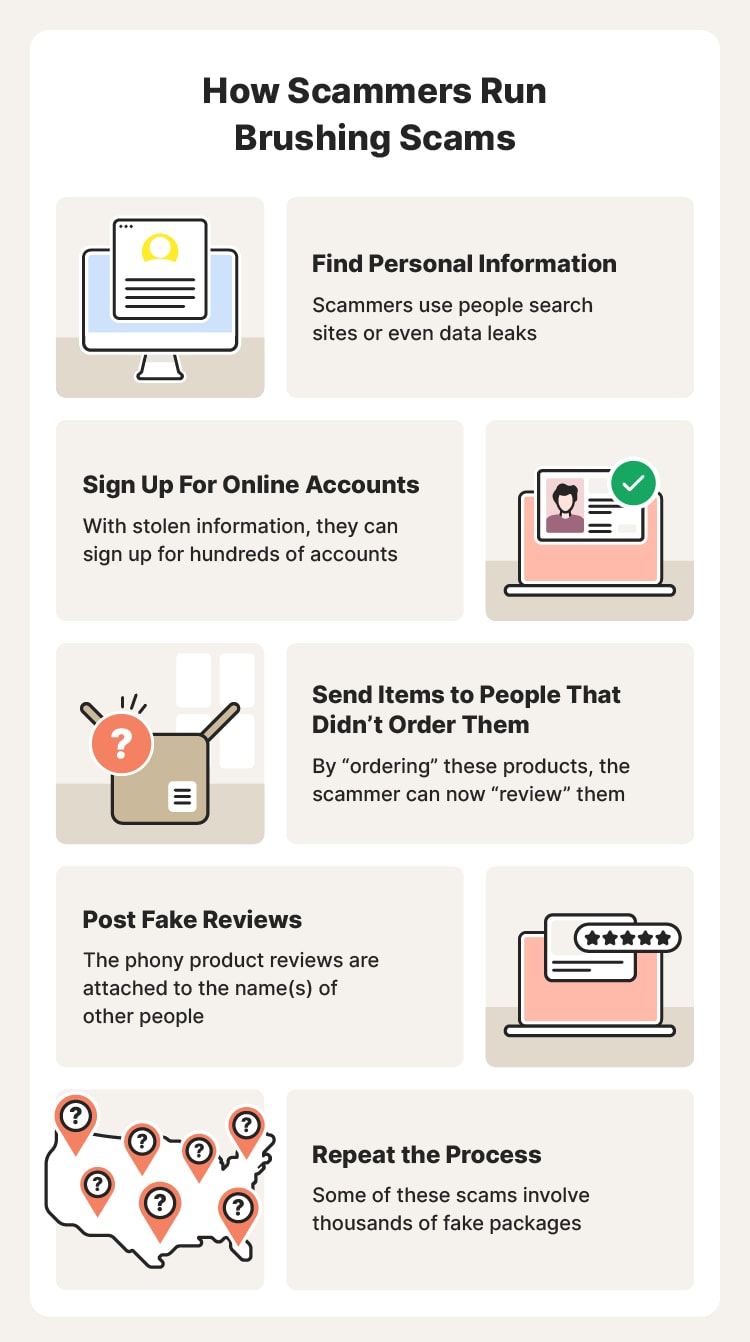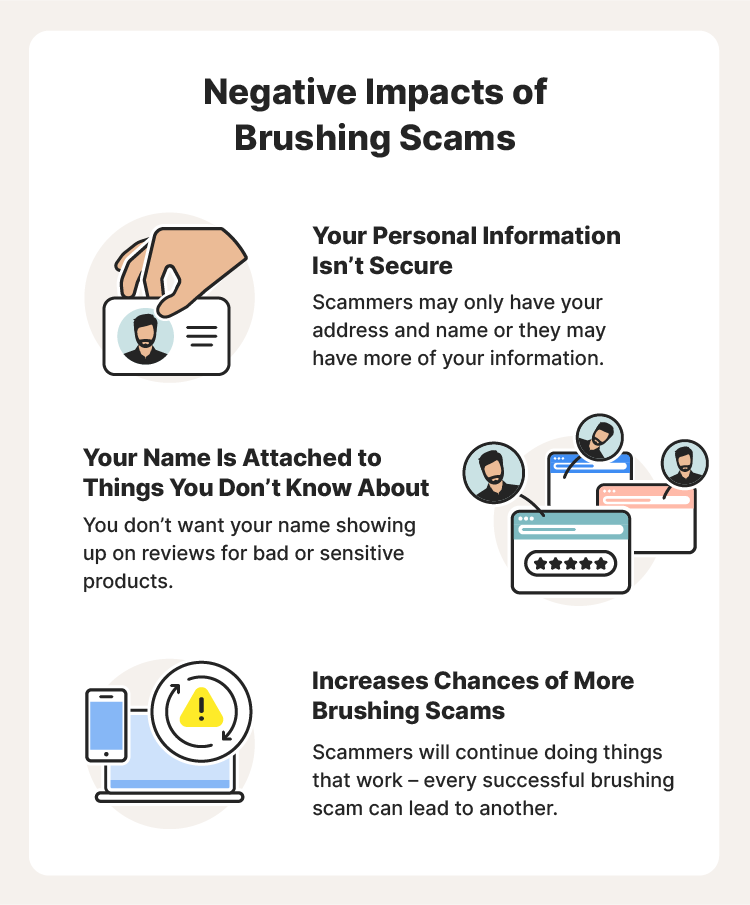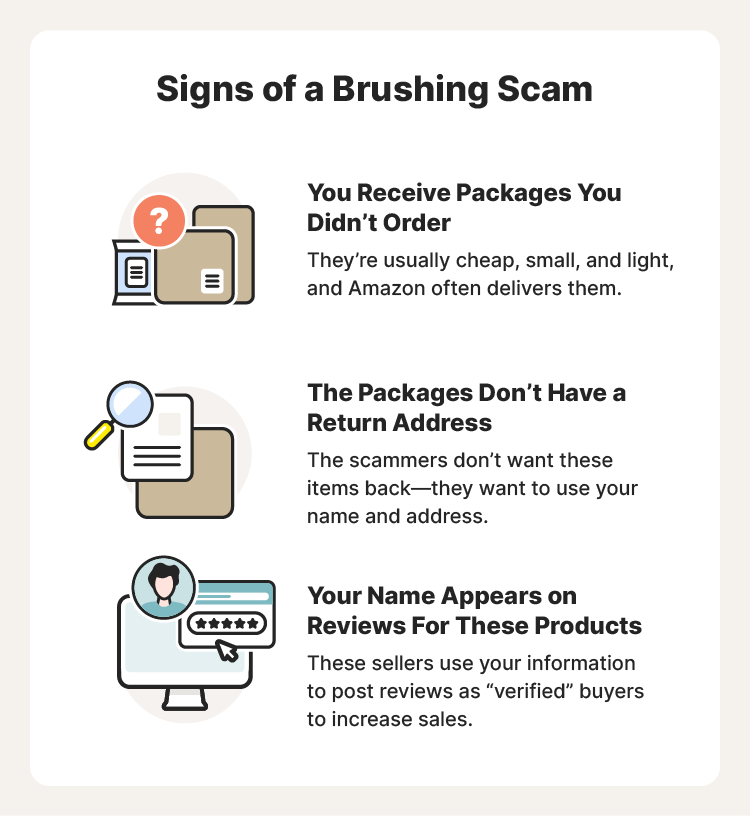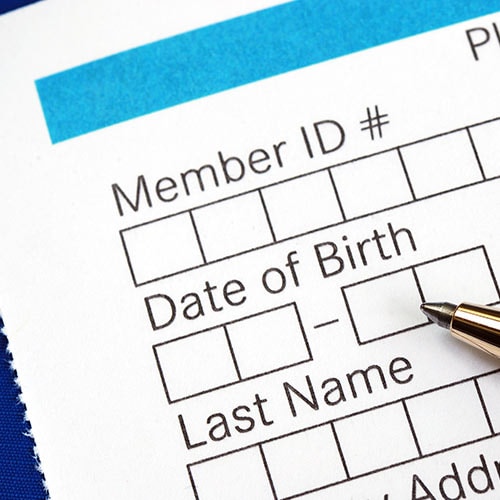What is a brushing scam?
Brushing scams are a type of e-commerce fraud that involve scammers sending packages to people that they never ordered. Using other people’s names and addresses, brushing scammers sign up for accounts on online marketplaces, send unsolicited packages to those addresses, and then post fake reviews to make their products look like they’re widely used.
How do brushing scams work?
Online stores and third-party sellers thrive when their products receive high volumes of great reviews. But what do they do if they’re trying to sell cheap or poor-quality products in a market that’s already saturated? If they’re a dishonest retailer, they may start a brushing scam.
The process is fairly simple:
- Scammers search for personal information. The seller goes online and finds people’s names and addresses using people search or data broker sites or perusing the dark web for data breaches.
- Scammers use addresses and names to open accounts: Using this stolen information, they can open hundreds of new accounts at their online store or a marketplace where the seller will list their products.
- These scammers then “buy” their own goods and send them to your house. By making these fake purchases, they gain “verified” status.
- Scammers use their status as a “verified” account to write positive product reviews. As “verified” buyers, they can post reviews that may be weighed more heavily than other reviewers.
- Scammers repeat this process over and over again. Some brushing scams involve thousands of fake accounts and reviews that are designed to make it look as if their products have been purchased and used by many people.

Negative impacts of brushing scams
While it might not seem so bad to get an Amazon gift from an unknown sender, brushing scams can have real negative consequences, including putting you at a higher risk of identity theft.
Here are a few of the consequences of a brushing scam:
- Your personal and financial information could be exposed. While your name and address might not be enough for a scammer to steal your identity, it does mean that your personally identifiable information is available for people to find or purchase. Sometimes, scammers come across it legally by using a people search site or buying names from a marketing research company. However, many of these scammers aren’t above buying data from people on the dark web who obtained your information from a data breach or hacking. Keep a close eye on your bank accounts and credit card statements in weeks and months following a brushing scam to look for any suspicious charges.
- Your name is being used without your knowledge or permission. Having your name used for products you don’t use, especially if they could be potentially sensitive in nature, is a real concern. Brushing lets scammers attach your name to items you don’t want to be associated with.
- If the scammer succeeds with a brushing scam, they’re more likely to do it again. That puts everyone’s information at risk as these scams grow over time. It also means that the next time you get online to buy something, you could see great reviews for cheap products that won’t meet your needs. So even if you do everything to avoid having your name used in a brushing scam, it could mean that you’re still being impacted by these schemes.

What are the signs of a brushing scam?
Once in a while, a delivery person will accidentally deliver a package to your home that should have gone to your neighbor’s home or a local business. That’s not a sign of a brushing scam, but if any or all of the following happen, it could mean you’re a part of a brushing scam:
- You receive items you didn’t order.
- The packages don’t have a return address.
- Your name shows up on reviews for these products.

How to stop brushing scams
While you don’t have to do anything if a scammer sends free items to your home, doing your part to stop these scams can help others (and even yourself) in the future.
Contact the marketplace or store
If you received an Amazon package you didn’t order that you think is a part of a brushing scam, contact them. Amazon doesn’t allow brushing, so they will investigate and try to prevent the seller from listing their products on Amazon.
Discard or return the package
Because most of the items sent during a brushing scam are cheap, they usually aren’t very useful or relevant to your interests. You can contact the delivery company and return the package if there is a return address (but don’t pay any fees for unsolicited packages). You can also throw the items away.
Don’t pay for the packages
Whatever you decide to do with the items you receive during a brushing scam, don’t pay for them if a seller reaches out to you. If the delivery company says that postage is due, inform them that you didn’t place the order and want it returned to the sender.
Change your passwords
Good data privacy practices start with your first line of defense: Your passwords. Password security means using unique passwords for every site you use and making them as strong as possible by combining letters, numbers, and special characters.
Set up 2FA
To help users protect their data, many companies have started offering two-factor authentication (2FA). If you’ve received brushing scam packages, start using 2FA to make it more difficult for scammers to access your accounts. This extra layer of protection uses your phone number or an authenticator app to prove it’s you.
Check your bank and credit accounts for fraud
While it’s possible that a scammer who used your name and address during a brushing scam purchased that information from a data broker or found it on a people search site, they may have found your data on the dark web. If they found it there, it might include your financial information, like your bank and credit account numbers and logins.
After a brushing scam, monitor your bank accounts and credit accounts closely for several months to make sure no one is using these accounts. If suspicious activities occur, report it to your financial institutions. You may want to request new cards and account numbers, too.
Consider freezing or locking your credit report
If you have reason to believe that somebody found your information in a data breach and sold it to a scammer, you may want to consider a credit freeze or lock to prevent anyone else from trying to open new credit accounts in your name. You can remove these locks and freezes whenever you need to apply for credit.
Complete a dark web scan
A dark web scan is a service that crawls the unindexed part of the internet to look for your personal data. You can find one-time scan services or sign up for ongoing dark web monitoring that will notify you as soon as your information shows up somewhere it shouldn’t be.
Report the fraud to the FTC
Reporting identity theft and scams to the FTC can help law enforcement fight these types of crime. The FTC also offers additional information about how to recover from identity theft and news about scams to be aware of.

Sign up for identity theft protection.
Identity theft protection services detect and alert you to threats and suspicious activity related to your identity to stop it from happening or limit the damage identity theft can have on your life. LifeLock Standard watches your credit report, scans public people search sites for your information (and helps you opt-out from having your information listed), and includes Dark Web Monitoring to help you know if your data ends up where it shouldn’t be.
FAQs about brushing scams
Want to learn more about brushing scams? Keep reading for some answers.
Can you keep items sent to you as a part of a brushing scam?
Yes. Federal law says you can’t be forced to pay for items you didn’t order. But be careful if you open these packages and use whatever is inside as some of these items may be cheaply made and unsafe.
How do scammers get my name and address for a brushing scam?
They may have found it on the dark web, on a data broker site, or through a marketing research company.
Why is it called brushing?
It’s called a brushing scam because the scammer will “brush up” (embellish or create fake) reviews of their products to create a false impression of the quality of the items they sell. Another definition says that the phrase comes from how fake reviews are “brushing aside suspicion” by falsely improving product rankings and creating a sense of trust in the product.
How do I stop Amazon brushing scams?
Report any brushing scams sent through Amazon directly to Amazon. They will investigate and try to stop the scammer from doing it again by banning them from their marketplace.
How can I prevent being scammed?
Staying informed about the latest scams can help you identify them before anything bad happens. Following strong online security measures, like not clicking links or opening attachments from people you don’t know, can help. Identity theft protection services can monitor the web and notify you if your data is in a breach or on the dark web.
Are brushing scams dangerous?
Brushing scams may mean that your name, address, and other personal information is available to scammers and others who might use it for illegal reasons. Some items sent during these scams can be dangerous.
I received an Amazon package I didn't order: what should I do?
Contact Amazon to report the issue. They won’t make you return the item.
Editor’s note: Our articles provide educational information. LifeLock offerings may not cover or protect against every type of crime, fraud, or threat we write about.
This article contains
Start your protection,
enroll in minutes.
Copyright © 2024 Gen Digital Inc. All rights reserved. All trademarks, service marks, and tradenames (collectively, the "Marks") are trademarks or registered trademarks of Gen Digital Inc. or its affiliates ("Gen") or other respective owners that have granted Gen the right to use such Marks. For a list of Gen Marks please see GenDigital.com/trademarks.




